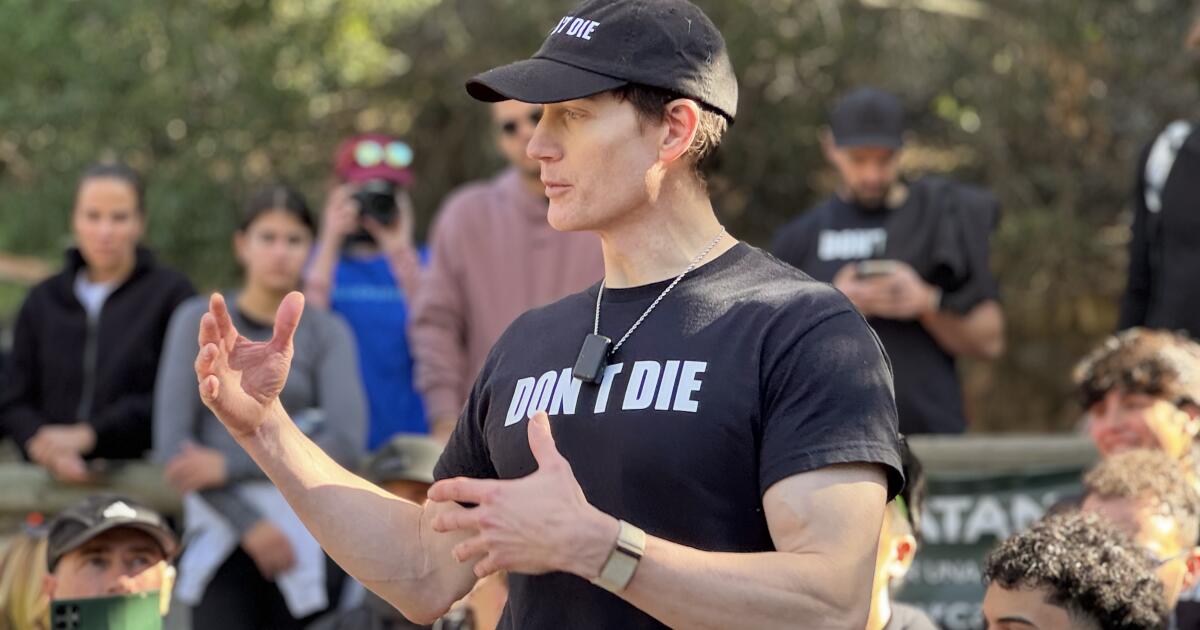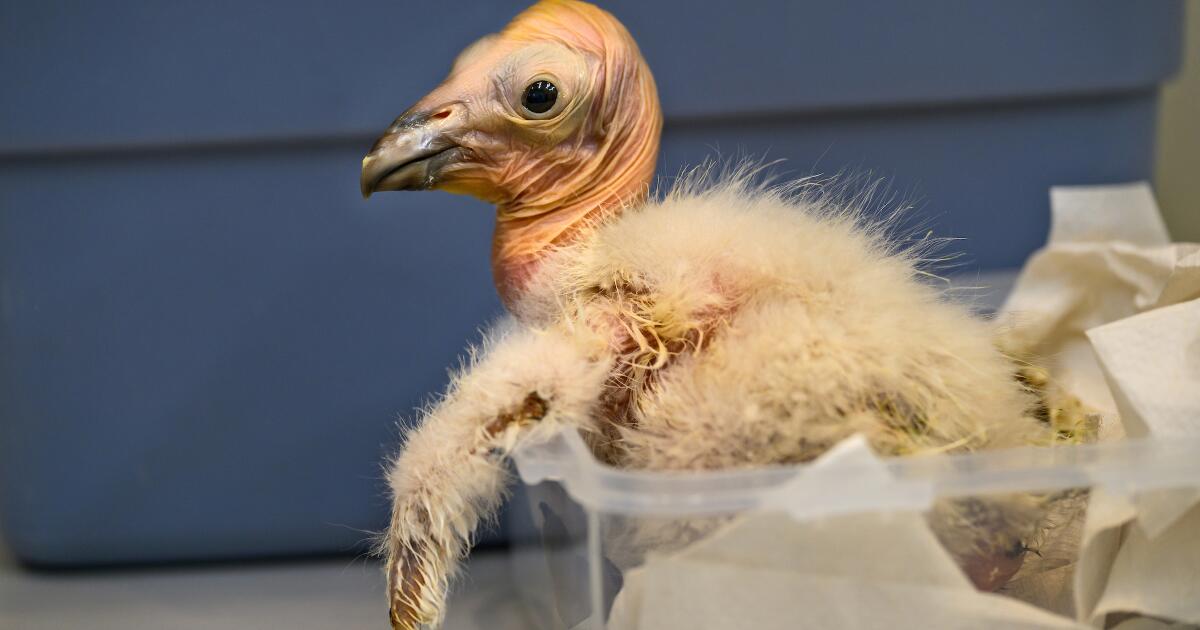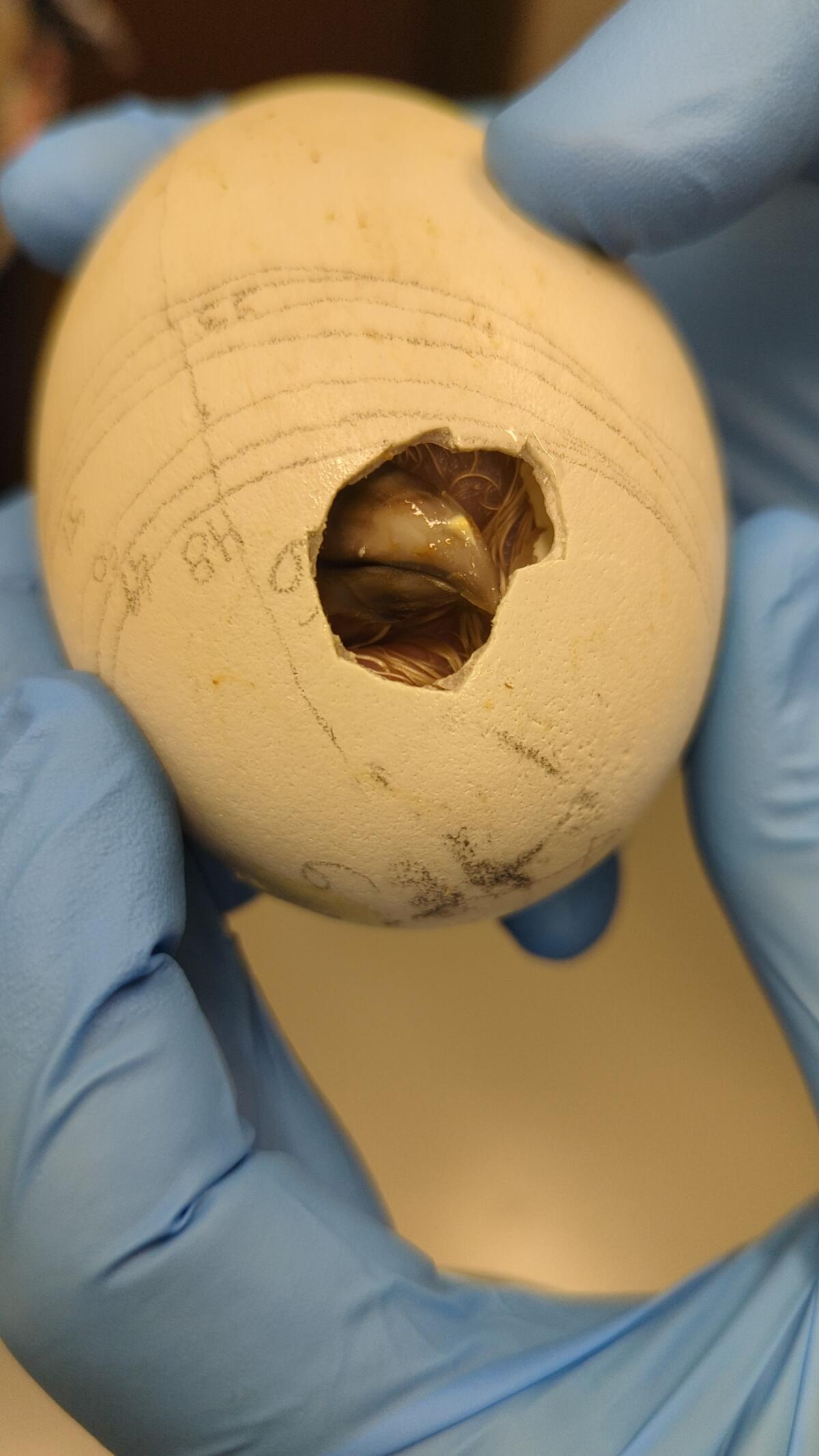Science
Column: Still searching for the fountain of youth? Don't drown in all the hype

Given the long list of major catastrophes in the world — melting polar ice, raging wars, the disappearance of early-bird specials, etc. — I’m not sure why so many people want to live forever. But they do, and the multibillion-dollar longevity industry is booming.
Supplements, skincare products, cosmetic surgery, books, diets, podcasts, workout routines — all of this is available to anyone who wants to halt or reverse the aging process, or at least try.
David Sinclair, a 54-year-old Harvard geneticist, told Fortune magazine he’s getting back to his 20-year-old brain. He’s on a plant-based diet with supplements designed to jump-start his longevity genes. He’s also managed to activate his bank account with a bestselling book called “Lifespan: Why We Age — And Why We Don’t Have To.”
California is about to be hit by an aging population wave, and Steve Lopez is riding it. His column focuses on the blessings and burdens of advancing age — and how some folks are challenging the stigma associated with older adults.
Tech entrepreneur and anti-aging guru Bryan Johnson of Los Angeles takes it a step further. He’s 46 in real time but is trying to get back to 18. He says death is optional, and it’s presumably less likely if you sign up for his $333-monthly line of supplemental products. Johnson downs 100 or so supplements daily and performs about two dozen exercises. He wears a T-shirt that says, “Don’t Die,” eats something he calls “nutty pudding” and sleeps with a penis monitor to count nighttime erections.
Such a routine would actually shorten my life, because after a week or so of that, I’d hurl myself in front of a bus.
Thankfully, not everyone is easily duped by claims of immortality. Charles Brenner, an acclaimed authority on metabolism and disease, first contacted me a year ago to say, “I’m very bothered by bulls— claims in longevity science.”
The City of Hope biochemist has used science to poke holes in one life-extension claim after another, including those of Sinclair and Johnson, and has become known as the longevity skeptic and the great debunker.
When we met for a cup of coffee one recent morning in Sierra Madre, he began the conversation with a reference to the Greek historian Herodotus, who wrote about dipping in magical waters that can keep you forever young. But there was no fountain of youth back then, Brenner noted, and the latest claims of its existence are sure to ultimately disappoint the long lines of lemmings.
“Partially, it’s media, and a worship of youth as opposed to a respect for aging and wisdom,” Brenner said. “We all want to retain our facilities and our ability to provide for others, so I think that’s normal and healthy. But there’s a lot of anxiety that is driving the obsession with anti-aging, and I do believe there have been some false promises and obfuscation from some figures at the interface of academia and investment.”
That’s not to say there are no pathways to healthier living, or that there is no promising research into detection, prevention and treatment of life-shortening diseases. Brenner discovered in his own research that a vitamin called nicotinamide riboside is useful “in promoting resiliency and repair in aging. “We’re doing randomized clinical trials to test its efficacy in a variety of age-related conditions” including Parkinson’s disease. “I don’t think it’s going to extend life span,” he said, “but I do think … it’s something that can help people maintain their resiliency.”
This brings up an important distinction — that medical breakthroughs and healthier lifestyles can help us lengthen our health span, if not our life span. We all have to eventually “leave the feast of life,” as Brenner puts it, but there’s hope that we can enjoy healthier and more active years while we’re still standing.
Psychology professor Laura Carstensen, director of the Stanford Longevity Center, said she doesn’t know of any evidence that we can live forever, or what kind of nightmare that might be.
“People are profiting mightily from what might be snake oil,” she said. “But the scientific community doesn’t know what the best measures are right now, and we don’t want people to stop looking for them.”
In Carstensen’s view, we have an astronomically expensive disease-care system rather than a healthcare system, and she wouldn’t bet a nickel on an overhaul by the federal government. So she’s holding out hope for legitimate private sector forays into early detection and intervention. As an example, she points out that preventing diabetes is a lot less expensive than treating it.
“Geroscience is often misrepresented as helping people live forever. It’s not. It’s about health span, and altering the processes that put us at risk for virtually all diseases,” Carstensen said.
Just before I met with Brenner, a PR firm offered me an interview with Irina Conboy, a UC Berkeley professor who has co-founded a company called Generation Lab. I was initially skeptical because the pitch said Conboy was responsible for a number of “research breakthroughs… on the discovery that aging is malleable and can be rapidly reversed, through rejuvenating blood circulation.”
Another fountain of youth proposition?
But the same pitch said Generation Lab’s process involves peer-reviewed science, and employs a series of cheek swab tests “to measure clinically relevant biological ‘alarm signals’ that report biological age and risk of disease.” Clients would get an assessment of the condition of cardiac, respiratory, urinary and other body systems, and through a pairing with a physician, interventions could be prescribed to “address conditions that rob people of their quality of life and independence as they age — extending the human health span.”
Conboy told Fortune she was trying to steer people away “from the dangers of pseudo longevity.” She said that “aging is not something that is set in stone like a train going on a track,” and that “the overarching goal is to delay or perhaps reverse or even prevent diseases.”
Can Generation Lab deliver on its promises? That remains to be seen, but more than 1,000 people are already on a waiting list for the cheek swab intervention, which costs $400. And that brings up a question of medical ethics.
We already have a crisis of inequity when it comes to access to diagnostics and quality healthcare. As the world’s unprecedented age wave accelerates and the percentage of older people grows, are we establishing new barriers between those who can, and can’t, afford the latest trials and interventions?
“We’re trying to get this as accessible as possible” and to make Generation Lab cheaper after the March trials begin, said CEO Alina Rui Su, who told me one goal is to eventually bring down the price of admission.
I told Conboy the thought of swabbing my cheek and waiting for the results, which might be alarming, could keep me awake at night. And what’s wrong with instead having good old-fashioned regular checkups with my doctor?
Those checkups won’t necessarily identify early signs of trouble, she said, but the Generation Lab diagnostics might.
“Would you want to know that three years from now, or five years from now, you might develop a bad cancer, and knowing might allow you” to begin interventions? she asked.
Good question. I suppose I would, though I think I’ll wait until the price goes down.
Getting more out of our limited time is a worthy endeavor, for sure. But at the risk of being a party pooper, let’s not forget that we’re all dying. Despite the claims of some, it’s the natural order. And there is an aspect of the longevity boom that frames aging, and elderhood, as a wretched disease, to be avoided at any cost. If that’s your outlook, the stress alone might very well kill you, no matter how many pills you take.
My amateur geroscience prescription, free of charge, is that you avoid buying any snake oil, skip the penis monitors, eat right and sleep tight, get some exercise and do things that give you a sense of purpose and pleasure.
If that gets you through today, try it again tomorrow.
steve.lopez@latimes.com

Science
Q&A: Learn how Olympians keep their cool from Team USA's chief sports psychologist

Your morning jog or weekly basketball game may not take place on an Olympic stage, but you can use Team USA’s techniques to get the most out of your exercise routine.
It’s not all about strength and speed. Mental fitness can be just as important as physical fitness.
That’s why the U.S. Olympic & Paralympic Committee created a psychological services squad to support the mental health and mental performance of athletes representing the Stars and Stripes.
“I think happy, healthy athletes are going to perform at their best, so that’s what we’re striving for,” said Jessica Bartley, senior director of the 15-member unit.
Bartley studied sports psychology and mental health after an injury ended her soccer career. She joined the USOPC in 2020 and is now in Paris with Team USA’s 592 competitors, who range in age from 16 to 59.
Bartley spoke with The Times about how her crew keeps Olympic athletes in top psychological shape, and what the rest of us can learn from them. Her comments have been edited for length and clarity.
Why is exercise good for mental health?
It gets you moving. It gets the endorphins going. And there’s often a lot of social aspects that are really helpful.
There are a number of sports that stretch your brain in ways that can be really, really valuable. You’re thinking about hand-eye coordination, or you’re thinking about strategy. It can improve memory, concentration, even critical thinking.
What’s the best way to get in the zone when it’s time to compete?
When I work with athletes, I like to understand what their zone is. If a 0 or a 1 is you’re totally chilled out and a 10 is you’re jumping around, where do you need to be? What’s your number?
People will say, “I’m at a 10 and I need to be at an 8 or a 7.” So we’ll talk about ways of bringing it down, whether it’s taking a deep breath, listening to relaxing music, or talking to your coach. Or there’s times when people say they need to be more amped up. That’s when you see somebody hitting their chest, or jumping up and down.
If you make a mistake in the middle of a competition, how do you move on instead of dwelling on it?
I often teach athletes a reset routine. I played goalie, so I had a lot of time to think after getting scored on. I would undo my goalie gloves and put them back on, which to me was a reset. I would also wear an extra hairband on my wrist, and when I would snap it, that meant I needed to get out of my head.
It’s not just a physical reset — it helps with a mental reset. If you do the same thing every single time, it goes through the same neural pathway to where it’s going to reset the brain. That can be really impactful.
Do Olympic athletes have to deal with burnout?
Oh, yeah. Everybody has a day where they don’t want to do whatever it is. That’s when you have to ask, “What’s in my best interests? Do I need a recovery day, or do I really need to get in the pool, or get in the gym?”
Sometimes you really do need what we like to refer to as a mental health day.
How can you psych yourself up for a workout when you just aren’t feeling it?
It’s really helpful to think about why you’re doing this and why you’re pushing yourself. Do you have goals related to an activity or sport? Is there something tied to values around hard work or discipline, loyalty or dependability?
When you don’t want to get in the gym, when you don’t want to go for a run, think about something bigger. Tie it back to values.
Is sleep important for maintaining mental health?
Yes! We started doing mental health screens with athletes before the Tokyo Games. We asked about depression, anxiety, disordered eating and body image, drugs and alcohol, and sleep. Sleep was actually our No. 1 issue. It’s been a huge initiative for us.
How much sleep should we be getting?
It’s different for everyone, but generally we know seven to nine hours of sleep is good. Sometimes some of these athletes need 10 hours.
I highly recommend as much sleep as you need. If you didn’t get enough sleep, napping can be really valuable.
Is napping just for Olympic athletes or is it good for everybody?
Everybody! Naps are amazing.
What if there’s no time for a nap?
There are different ways of recharging. Naps could be one of them, but maybe you just need to get off your feet for 20 minutes. Maybe you need to do a meditation or mindfulness exercise and just close your eyes for five minutes.
How do you minimize the effects of jet lag?
We try to shift one hour per day. That’s the standard way of doing it. If you can, it’s super helpful. But it’s not always possible.
The thing we tell athletes is that our bodies are incredible, and you will even things out if you can get back on schedule. One or two nights of crummy sleep is not going to impact your overall performance.
What advice do you give athletes who have trouble falling asleep the night before a competition?
You don’t want to change much right before a competition, so I usually direct athletes to do what they would normally do.
Do you need to unwind by reading a book? Do you need to talk on the phone with somebody and get your mind off things? Can you put your mind in a really restful place and think about things that are really relaxing?
Are there any mindfulness or meditation exercises that you find helpful?
There are some athletes who benefit greatly from an hourlong meditation. I love something quick, something to reset my brain, maybe close my eyes for a minute.
If I’m feeling like I need to take a moment, I love mindful eating. You savor a bite and go, “Oh, my gosh, I have not been fully engaged with my senses today.” Or you could take a mindful walk and take in the sights, the smells, all of the things that are around you.
What do you eat when you need a quick nutrition boost?
Cashews. I tend to carry those with me. They’ve got enough energy to make sure I keep going, physically.
I’ve always got gummy bears on me too. There’s no nutritional value but they keep me going mentally. I’m a big proponent of both.
Is it OK to be superstitious in sports?
It depends how flexible you are. Maybe you put on your socks or shoes a certain way, or listen to certain music. Routines are really soothing. They set your brain up for success in a particular performance. It can be really, really helpful.
But I’ve also seen an athlete forget their lucky underwear or their lucky socks, and they’re all out of sorts. So your routine has to be flexible enough that you’re not going to completely fall apart if you don’t do it exactly.
Are Olympians made of stronger psychological stuff than the rest of us?
Not necessarily. There are some who don’t get feathers ruffled and have a high tolerance for the fanfare. There’s also a lot of regular human beings who just happen to be fantastic at a particular activity.
Science
‘Ready, Steady, Slow’: Championship Snail Racing at 0.006 M.P.H.

Earlier this month, the rural village of Congham, England, played host to a less likely group of athletes: dozens of garden snails. They had gathered to compete in the World Snail Racing Championships, where the world record time for completing the 13.5 inch course stands at 2 minutes flat. At that speed — roughly 0.006 miles per hour — it would take the snails more than six days to travel a mile.
Science
Caring for condor triplets! Record 17 chicks thrive at L.A. Zoo under surrogacy method

A new method of rearing California condors at the Los Angeles Zoo has resulted in a record-breaking 17 chicks hatched this year, the zoo announced Wednesday.
All of the newborn birds will eventually be considered for release into the wild under the U.S. Fish and Wildlife Service’s California Condor Recovery Program, a zoo spokesperson said.
“What we are seeing now are the benefits of new breeding and rearing techniques developed and implemented by our team,” zoo bird curator Rose Legato said in a statement. “The result is more condor chicks in the program and ultimately more condors in the wild.”
Breeding pairs of California condors live at the zoo in structures the staff “affectionately calls condor-miniums,” spokesperson Carl Myers said. When a female produces a fertilized egg, the egg is moved to an incubator. As its hatching approaches, the egg is placed with a surrogate parent capable of rearing the chick.
California condor eggs are cared for at L.A. Zoo. The animal is critically endangered.
(Jamie Pham / L.A. Zoo)
This bumper year of condor babies is the result of a modification to a rearing technique pioneered at the L.A. Zoo.
Previously, when the zoo found itself with more fertilized eggs than surrogate adults available, staff raised the young birds by hand. But condors raised by human caretakers have a lower chance of survival in the wild (hence the condor puppets that zookeepers used in the 1980s to prevent young birds from imprinting on human caregivers).
In 2017, the L.A. Zoo experimented with giving an adult bird named Anyapa two eggs instead of one. The gamble was a success. Both birds were successfully released into the wild.
Faced with a large number of eggs this year, “the keepers thought, ‘Let’s try three,’” Myers said. “And it worked.”
The zoo’s condor mentors this season ultimately were able to rear three single chicks, eight chicks in double broods and six chicks in triple broods. The previous record number of 15 chicks was set in 1997.
Condor experts applauded the new strategy.
“Condors are social animals and we are learning more every year about their social dynamics. So I’m not surprised that these chick-rearing techniques are paying off,” said Jonathan C. Hall, a wildlife ecologist at Eastern Michigan University. “I would expect chicks raised this way to do well in the wild.”
The largest land bird in North America with an impressive wingspan up to 9½ feet, the California condor could once be found across the continent. Its numbers began to decline in the 19th century as human settlers with modern weapons moved into the birds’ territory. The scavenger species was both hunted by humans and inadvertently poisoned by lead bullet fragments embedded in carcasses it ate. The federal government listed the birds as an endangered species in 1967.

A condor, one of a record-breaking 17 at the zoo, makes its way out of its shell.
(Jamie Pham / L.A. Zoo)
When the California Condor Recovery Program began four decades ago, there were only 22 California condors left on Earth. As of December, there were 561 living individuals, with 344 of those in the wild. Despite the program’s success in raising the population’s numbers, the species remains critically endangered.
In addition to the ongoing threat of lead poisoning, the large birds are also at risk from other toxins. One 2022 study found more than 40 DDT-related compounds in the blood of wild California condors — chemicals that had made their way from contaminated marine life to the top of the food chain.
“Despite our success in returning condors to the wild, free-flying condors continue to face many obstacles with lead poisoning being the No. 1 cause of mortality,” said Joanna Gilkeson, spokesperson for Fish and Wildlife’s Pacific Southwest Region. “Innovative strategies, like those the L.A. Zoo is implementing, help us to produce more healthy chicks and continue releasing condors into the wild.”
The chicks will remain in the zoo’s care for the next year and a half before they are evaluated for potential release to the wild. Thus far, the zoo has contributed 250 condor chicks to Fish and Wildlife’s program, some of which the agency has redeployed to other zoos as part of its conservation efforts.
In a paper published earlier this year, a team of researchers found that birds born in captivity have slightly lower survival rates for their first year or two but then have equally successful outcomes to wild-hatched birds.
“Because condors reproduce slowly, releases of captive-bred birds are essential to the recovery of the species, especially in light of ongoing losses due to lead-related mortality,” said Victoria Bakker, a quantitative ecologist at Montana State University and lead author of the paper. “The team at the L.A. Zoo should be recognized for their innovative and important contributions to condor recovery.”
-

 World1 week ago
World1 week agoOne dead after car crashes into restaurant in Paris
-

 Midwest1 week ago
Midwest1 week agoMichigan rep posts video response to Stephen Colbert's joke about his RNC speech: 'Touché'
-

 News1 week ago
News1 week agoVideo: Young Republicans on Why Their Party Isn’t Reaching Gen Z (And What They Can Do About It)
-

 News1 week ago
News1 week agoIn Milwaukee, Black Voters Struggle to Find a Home With Either Party
-

 Politics1 week ago
Politics1 week agoFox News Politics: The Call is Coming from Inside the House
-

 News1 week ago
News1 week agoVideo: J.D. Vance Accepts Vice-Presidential Nomination
-

 Movie Reviews1 week ago
Movie Reviews1 week agoMovie Review: A new generation drives into the storm in rousing ‘Twisters’
-

 World1 week ago
World1 week agoTrump to take RNC stage for first speech since assassination attempt




/cdn.vox-cdn.com/uploads/chorus_asset/file/25547838/YAKZA_3840_2160_A_Elogo.jpg)










